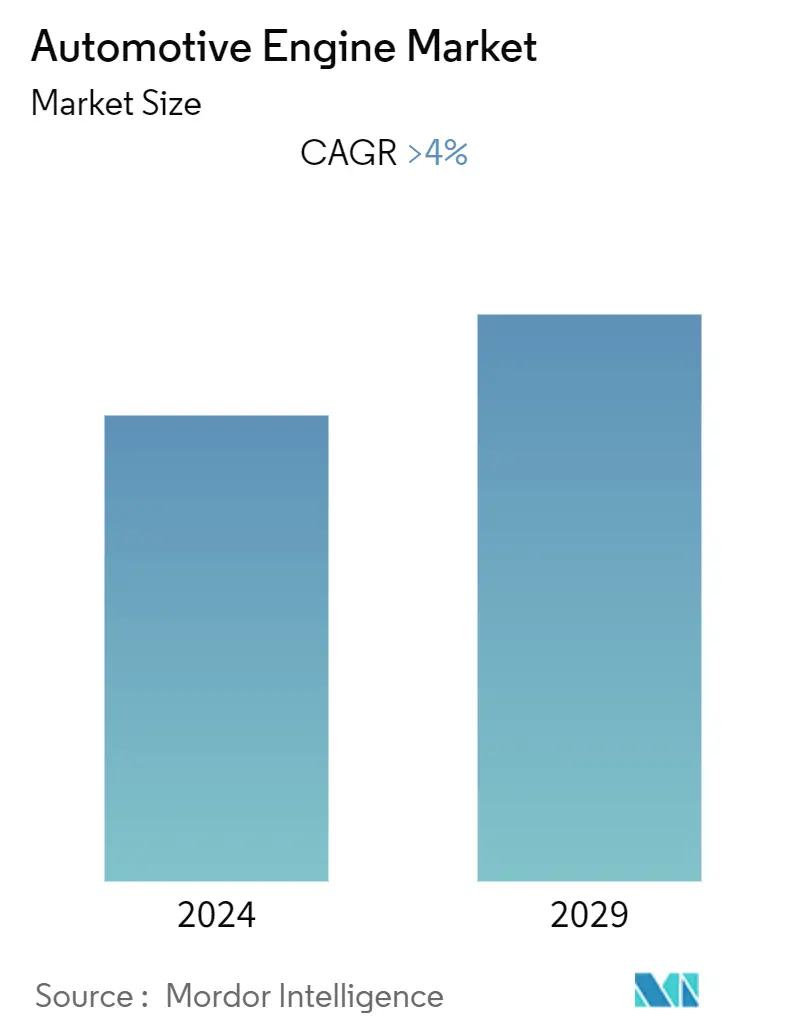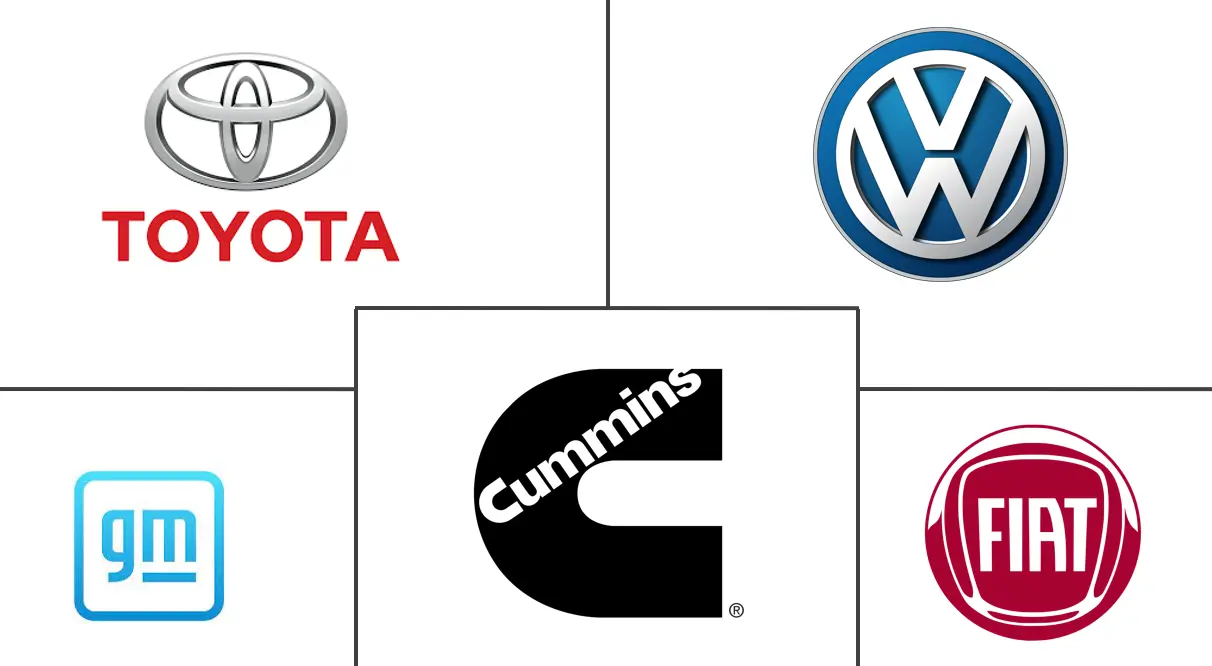Market Size of Automotive Engine Industry

| Study Period | 2019 - 2029 |
| Base Year For Estimation | 2023 |
| CAGR (2024 - 2029) | 4.00 % |
| Fastest Growing Market | Asia-Pacific |
| Largest Market | Asia-Pacific |
| Market Concentration | Medium |
Major Players
*Disclaimer: Major Players sorted in no particular order |
Automotive Engine Market Analysis
The Automotive Engine Market is expected to register a CAGR of greater than 4% during the forecast period.
The market is valued at USD 395 billion and is expected to reach over USD 500 billion.
The COVID-19 pandemic had a swift and negative impact on the globally integrated automotive industry. Automobile engine and component manufacturing plants have been shut down, and consumer footfalls in showrooms have fallen sharply because of lockdowns and travel restrictions worldwide.
However, the automotive engine market is expected to witness significant growth during the forecast period, as manufacturers are focusing on new technologies like the replacement of engine control units to increase the average life of vehicles, thereby improving the lifecycle of engines. The growing demand for fuel-efficient and lightweight vehicles will likely create lucrative opportunities for players in the market during the forecast period.
Moreover, with the rising electrification of the fleet, OEMs are seen closing down their respective production bases. For instance, In November 2022, Stellantis announced the closure of its Fiat Powertrain Technologies (FPT) engine plant in Campo Largo, Brazil. It came after the company aimed to achieve zero emissions by 2038.
The Asia-Pacific region is anticipated to continue as a significant market for automotive engines throughout the forecasted period. Both North America and Asia-Pacific regions dominate the global automotive engine market as several environmental norms are employed in North America, Europe, and Asia-Pacific.
Automotive Engine Industry Segmentation
Automotive engines are the vehicle's central heart, also called the powerhouse. These engines are generally offered as petrol and diesel engine, which uses heat energy produced during the combustion to provide mechanical output to the drive shaft.
The Automotive Engine Market is segmented by placement type (In-line Engine, W Engine, and V-Type), vehicle type (passenger car and commercial vehicle), fuel type (gasoline and diesel), and geography (North America, Europe, Asia-Pacific, and rest of the world). The report offers market size and forecast for the automotive engine in terms of value (USD Billion) for all the above segments.
| Placement Type | |
| In-line Engine | |
| W Engine | |
| V-Type |
| Vehicle Type | |
| Passenger Car | |
| Commercial Vehicle |
| Fuel Type | |
| Gasoline | |
| Diesel | |
| Other Fuel Types |
| Geography | |||||||
| |||||||
| |||||||
| |||||||
|
Automotive Engine Market Size Summary
The automotive engine supplier market is poised for substantial growth, driven by advancements in engine technology and increasing demand for fuel-efficient vehicles. The market, which has been recovering from the adverse effects of the COVID-19 pandemic, is witnessing a shift towards innovative solutions such as hybrid and variable displacement engines. These developments are aimed at enhancing vehicle performance and reducing emissions, aligning with global environmental standards. The Asia-Pacific region is expected to maintain its dominance in the market, supported by robust vehicle sales and a strong presence of original equipment manufacturers (OEMs). Meanwhile, North America and Europe are also significant players, benefiting from established automotive industries and stringent emission regulations.
The market landscape is characterized by a fragmented structure with numerous players striving to gain a competitive edge through technological advancements. Key industry participants, including Cummins Inc., Toyota Motor Corporation, and General Motors, are actively investing in research and development to produce advanced engines that meet evolving consumer preferences and regulatory requirements. The rise of multi-fuel engine technology and the ongoing electrification of vehicles present both challenges and opportunities for market players. As the demand for gasoline and diesel engines remains strong, particularly in developing economies, the automotive engine market is expected to continue its upward trajectory, with significant contributions from regions like China and India.
Automotive Engine Market Size - Table of Contents
-
1. MARKET DYNAMICS
-
1.1 Market Drivers
-
1.2 Market Restraints
-
1.3 Industry Attractiveness - Porter's Five Forces Analysis
-
1.3.1 Bargaining Power of Suppliers
-
1.3.2 Bargaining Power of Consumers
-
1.3.3 Threat of New Entrants
-
1.3.4 Threat of Substitute Products
-
1.3.5 Intensity of Competitive Rivalry
-
-
-
2. MARKET SEGMENTATION (Market Size in Value USD Billion)
-
2.1 Placement Type
-
2.1.1 In-line Engine
-
2.1.2 W Engine
-
2.1.3 V-Type
-
-
2.2 Vehicle Type
-
2.2.1 Passenger Car
-
2.2.2 Commercial Vehicle
-
-
2.3 Fuel Type
-
2.3.1 Gasoline
-
2.3.2 Diesel
-
2.3.3 Other Fuel Types
-
-
2.4 Geography
-
2.4.1 North America
-
2.4.1.1 United States
-
2.4.1.2 Canada
-
2.4.1.3 Rest of North America
-
-
2.4.2 Europe
-
2.4.2.1 Germany
-
2.4.2.2 United Kingdom
-
2.4.2.3 France
-
2.4.2.4 Italy
-
2.4.2.5 Rest of Europe
-
-
2.4.3 Asia-Pacific
-
2.4.3.1 India
-
2.4.3.2 China
-
2.4.3.3 Japan
-
2.4.3.4 South Korea
-
2.4.3.5 Rest of Asia-Pacific
-
-
2.4.4 Rest of the World
-
2.4.4.1 South America
-
2.4.4.2 Middle-East and Africa
-
-
-
Automotive Engine Market Size FAQs
What is the current Automotive Engine Market size?
The Automotive Engine Market is projected to register a CAGR of greater than 4% during the forecast period (2024-2029)
Who are the key players in Automotive Engine Market?
Cummins Inc., Toyota Motor Corporation, General Motors, Volkswagen AG and Fiat Automobiles SpA are the major companies operating in the Automotive Engine Market.

